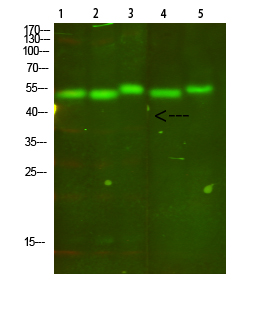产品名称
Cytochrome b Rabbit Polyclonal Antibody
别名
Cytochrome b (Complex III subunit 3) (Complex III subunit III) (Cytochrome b-c1 complex subunit 3) (Ubiquinol-cytochrome-c reductase complex cytochrome b subunit)
存储缓冲液
Liquid in PBS containing 50% glycerol, 0.5% BSA and 0.02% New type preservative N.
Human Gene Link
http://www.ncbi.nlm.nih.gov/sites/entrez?db=gene&term=4519
Human Swissprot No.
P00156
Human Swissprot Link
http://www.uniprot.org/uniprotkb/P00156/entry
Mouse Swissprot No.
P00158
Mouse Swissprot Link
http://www.uniprot.org/uniprot/P00158
免疫原
Synthesized peptide derived from human Cytochrome b. at AA range: 331-380
特异性
Cytochrome b Polyclonal Antibody detects endogenous levels of Cytochrome b
稀释度
WB 1:500-2000, ELISA 1:10000-20000
宿主
Polyclonal, Rabbit,IgG
背景介绍
cofactor:Binds 2 heme groups non-covalently.,disease:Defects in MT-CYB are a rare cause of mitochondrial dysfunction underlying different myopathies. They include mitochondrial encephalomyopathy, hypertrophic cardiomyopathy (HCM), and sporadic mitochondrial myopathy (MM). In mitochondrial myopathy, exercise intolerance is the predominant symptom. Additional features include lactic acidosis, muscle weakness and/or myoglobinuria. Defects in MTCYB are also found in cases of exercise intolerance accompanied by deafness, mental retardation, retinitis pigmentosa, cataract, growth retardation, epilepsy (multisystem disorder).,disease:Defects in MT-CYB are the cause of cardiomyopathy infantile histiocytoid (CMIH) [MIM:500000]. CMIH is characterized by the presence of pale granular foamy histiocyte-like cells within the myocardium. It usually affects children younger than 2 years of age, with a clear predominance of females over males. Infants present with dysrhythmia or cardiac arrest, and the clinical course is usually fulminant, sometimes simulating sudden infant death syndrome.,disease:Defects in MT-CYB contribute to Leber hereditary optic neuropathy (LHON) [MIM:535000]. LHON is a maternally inherited disease resulting in acute or subacute loss of central vision, due to optic nerve dysfunction. Cardiac conduction defects and neurological defects have also been described in some patients. LHON results from primary mitochondrial DNA mutations affecting the respiratory chain complexes.,function:Component of the ubiquinol-cytochrome c reductase complex (complex III or cytochrome b-c1 complex), which is a respiratory chain that generates an electrochemical potential coupled to ATP synthesis.,miscellaneous:Heme 1 (or BL or b562) is low-potential and absorbs at about 562 nm, and heme 2 (or BH or b566) is high-potential and absorbs at about 566 nm.,similarity:Belongs to the cytochrome b family.,subunit:The bc1 complex contains 11 subunits: 3 respiratory subunits (cytochrome b, cytochrome c1 and Rieske/UQCRFS1), 2 core proteins (UQCRC1/QCR1 and UQCRC2/QCR2) and 6 low-molecular weight proteins (UQCRH/QCR6, UQCRB/QCR7, UQCRQ/QCR8, UQCR10/QCR9, UQCR11/QCR10 and a cleavage product of Rieske/UQCRFS1).,
组织表达
Bone fossil,Heart,Lymphoblast,Placenta,
细胞定位
Mitochondrion inner membrane ; Multi-pass membrane protein .
信号通路
Oxidative phosphorylation;Cardiac muscle contraction;Alzheimer's disease;Parkinson's disease;Huntington's disease;
功能
cofactor:Binds 2 heme groups non-covalently.,disease:Defects in MT-CYB are a rare cause of mitochondrial dysfunction underlying different myopathies. They include mitochondrial encephalomyopathy, hypertrophic cardiomyopathy (HCM), and sporadic mitochondrial myopathy (MM). In mitochondrial myopathy, exercise intolerance is the predominant symptom. Additional features include lactic acidosis, muscle weakness and/or myoglobinuria. Defects in MTCYB are also found in cases of exercise intolerance accompanied by deafness, mental retardation, retinitis pigmentosa, cataract, growth retardation, epilepsy (multisystem disorder).,disease:Defects in MT-CYB are the cause of cardiomyopathy infantile histiocytoid (CMIH) [MIM:500000]. CMIH is characterized by the presence of pale granular foamy histiocyte-like cells within the myocardium. It usually affects children younger than 2 years of age, with a clear predominance of females over males. Infants present with dysrhythmia or cardiac arrest, and the clinical course is usually fulminant, sometimes simulating sudden infant death syndrome.,disease:Defects in MT-CYB contribute to Leber hereditary optic neuropathy (LHON) [MIM:535000]. LHON is a maternally inherited disease resulting in acute or subacute loss of central vision, due to optic nerve dysfunction. Cardiac conduction defects and neurological defects have also been described in some patients. LHON results from primary mitochondrial DNA mutations affecting the respiratory chain complexes.,function:Component of the ubiquinol-cytochrome c reductase complex (complex III or cytochrome b-c1 complex), which is a respiratory chain that generates an electrochemical potential coupled to ATP synthesis.,miscellaneous:Heme 1 (or BL or b562) is low-potential and absorbs at about 562 nm, and heme 2 (or BH or b566) is high-potential and absorbs at about 566 nm.,similarity:Belongs to the cytochrome b family.,subunit:The bc1 complex contains 11 subunits: 3 respiratory subunits (cytochrome b, cytochrome c1 and Rieske/UQCRFS1), 2 core proteins (UQCRC1/QCR1 and UQCRC2/QCR2) and 6 low-molecular weight proteins (UQCRH/QCR6, UQCRB/QCR7, UQCRQ/QCR8, UQCR10/QCR9, UQCR11/QCR10 and a cleavage product of Rieske/UQCRFS1).,
纯化
The antibody was affinity-purified from rabbit antiserum by affinity-chromatography using epitope-specific immunogen.

